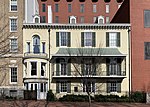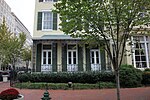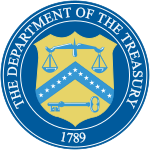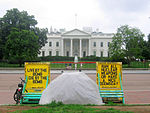Freedman's Bank Building

The Freedman's Bank Building, previously known as the Treasury Annex, is a historic office building located on the corner of Madison Place and Pennsylvania Avenue NW in Washington, D.C. It sits on the east side of Lafayette Square, a public park on the north side of the White House, and across from the Treasury Building. The adjoining properties include the Howard T. Markey National Courts Building to the north and former Riggs National Bank to the east. The current building is the third constructed on the site. The first, a house built in 1831, was later seized by the federal government during the Civil War. It was demolished and replaced with the elaborately decorated headquarters of Freedman's Savings Bank, established by Congress in 1865 for recently emancipated slaves and freedmen. Despite the bank's initial success, the combination of mismanagement, fraud, and the Panic of 1873 resulted in the bank's failure and closure in 1874. Over 60,000 African Americans collectively lost the equivalent of $75 million. This caused a distrust of the government and banks for many generations. The third and present building to be constructed on the site was the Treasury Annex, designed by Cass Gilbert in the Beaux-Arts style and completed in 1919. It was the first large federal building planned as part of a massive redevelopment of Lafayette Square. The McMillan Plan, which called for the demolition of all buildings on Madison Place and Jackson Place, was only partially completed in the Lafayette Square area. The other completed building, the U.S. Chamber of Commerce Building, was also designed by Gilbert. The initial plan of eventually expanding the Treasury Annex to H Street NW never happened due to several factors. The construction of Federal Triangle, the work of early historic preservationists, and assistance from President John F. Kennedy and First Lady Jacqueline Kennedy, meant several of the historic buildings on Madison Place were never demolished and the Annex was never expanded. The Annex was renamed the Freedman's Bank Building in 2016 to mark the importance of the site's history. The Freedman's Bank Building is a contributing property to the Lafayette Square Historic District, a National Historic Landmark, and to the Fifteenth Street Financial Historic District. It is also listed on the District of Columbia Inventory of Historic Sites. The Office of Foreign Assets Control, the Treasury Library, and the main branch of the Treasury Department Federal Credit Union are housed in the building.
Excerpt from the Wikipedia article Freedman's Bank Building (License: CC BY-SA 3.0, Authors, Images).Freedman's Bank Building
Madison Place Northwest, Washington
Geographical coordinates (GPS) Address Nearby Places Show on map
Geographical coordinates (GPS)
| Latitude | Longitude |
|---|---|
| N 38.898972222222 ° | E -77.035222222222 ° |
Address
448
Madison Place Northwest
20420 Washington
District of Columbia, United States
Open on Google Maps











